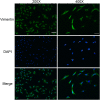Progranulin Promotes the Formation and Development of Capsules Caused by Silicone in Sprague-Dawley Rats
- PMID: 35967917
- PMCID: PMC9365064
- DOI: 10.2147/CCID.S374128
Progranulin Promotes the Formation and Development of Capsules Caused by Silicone in Sprague-Dawley Rats
Abstract
Background: Silicone implants are currently the most widely used artificial materials in plastic surgery. Capsule formation following implant application is unavoidable. When the capsule is excessively thick and strongly contracted, it can lead to obvious symptoms, clinically known as capsular contracture. Biological factors have always been the focus of research on the capsule formation. As a growth factor, progranulin (PGRN) plays an important regulatory role in wound healing, tissue fibrosis, tumor proliferation and invasion, and inflammation regulation. At present, the research on the capsule mainly involves the regulation of tissue healing and fibrosis under the influence of inflammation. Because PGRN has a regulatory role in these processes, we believe that the study of both can provide a new theoretical basis and intervention sites for monitoring and inhibiting the development of the capsule.
Methods: In this experiment, the effects of different surgical operations on the content of PGRN in the surgical site and plasma of rats were detected. Sprague-Dawley (SD) rat dermal fibroblasts were co-cultured by recombinant PGRN. The effects of r-PGRN on fibroblasts were detected by 5-ethynyl-2'-deoxyuridine (EdU) assay, wound healing assay and Western blot assay. Finally, the effect of PGRN on capsule formation and contracture was studied by changing the content of PGRN in the prosthesis in rats after operation.
Results: Surgical trauma and silicone implant increased plasma and local PGRN levels in SD rats. PGRN can activate the TGF-β/SMAD signaling pathway in a dose-dependent manner, thereby promoting fibroblast proliferation, differentiation and migration and inhibiting apoptosis and enhancing cell function, thereby promoting capsule formation and contracture.
Conclusion: PGRN promotes the formation and contracture of the silicone implant capsule in SD rats by activating the TGF-β/SMAD signaling pathway. This discovery may provide new therapeutic targets and detection indicators.
Keywords: TGF-β; fibroblast; fibrosis; implantation; silicone implants.
© 2022 Zhou et al.
Conflict of interest statement
The authors report no conflicts of interest in this work.
Figures






Similar articles
-
Progranulin: A promising biomarker and therapeutic target for fibrotic diseases.Acta Pharm Sin B. 2024 Aug;14(8):3312-3326. doi: 10.1016/j.apsb.2024.04.026. Epub 2024 May 6. Acta Pharm Sin B. 2024. PMID: 39220875 Free PMC article. Review.
-
Asiaticoside Combined With Carbon Ion Implantation to Improve the Biocompatibility of Silicone Rubber and to Reduce the Risk of Capsule Contracture.Front Bioeng Biotechnol. 2022 May 12;10:810244. doi: 10.3389/fbioe.2022.810244. eCollection 2022. Front Bioeng Biotechnol. 2022. PMID: 35646845 Free PMC article.
-
A multi-targeting bionanomatrix coating to reduce capsular contracture development on silicone implants.Biomater Res. 2023 Apr 22;27(1):34. doi: 10.1186/s40824-023-00378-7. Biomater Res. 2023. PMID: 37087537 Free PMC article.
-
Effect of Botulinum Toxin Type A on TGF-β/Smad Pathway Signaling: Implications for Silicone-Induced Capsule Formation.Plast Reconstr Surg. 2016 Nov;138(5):821e-829e. doi: 10.1097/PRS.0000000000002625. Plast Reconstr Surg. 2016. PMID: 27391832
-
Silicone breast implant modification review: overcoming capsular contracture.Biomater Res. 2018 Dec 20;22:37. doi: 10.1186/s40824-018-0147-5. eCollection 2018. Biomater Res. 2018. PMID: 30598837 Free PMC article. Review.
Cited by
-
Progranulin: A promising biomarker and therapeutic target for fibrotic diseases.Acta Pharm Sin B. 2024 Aug;14(8):3312-3326. doi: 10.1016/j.apsb.2024.04.026. Epub 2024 May 6. Acta Pharm Sin B. 2024. PMID: 39220875 Free PMC article. Review.
References
-
- Champaneria MC, Wong WW, Hill ME, et al. The evolution of breast reconstruction: a historical perspective. World J Surg. 2012;36:730–742. - PubMed
-
- Baino F. Scleral buckling biomaterials and implants for retinal detachment surgery. Med Eng Phys. 2010;32:945–956. - PubMed
-
- Anderson JM. Multinucleated giant cells. Curr Opin Hematol. 2000;7:40–47. - PubMed
-
- Gretzer C, Emanuelsson L, Liljensten E, et al. The inflammatory cell influx and cytokines changes during transition from acute inflammation to fibrous repair around implanted materials. J Biomater Sci Polym Ed. 2006;17:669–687. - PubMed
-
- Luttikhuizen DT, Harmsen MC, Van Luyn MJ. Cellular and molecular dynamics in the foreign body reaction. Tissue Eng. 2006;12:1955–1970. - PubMed
LinkOut - more resources
Full Text Sources
Research Materials

